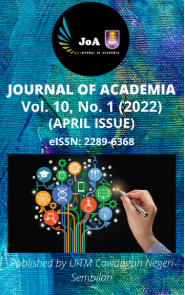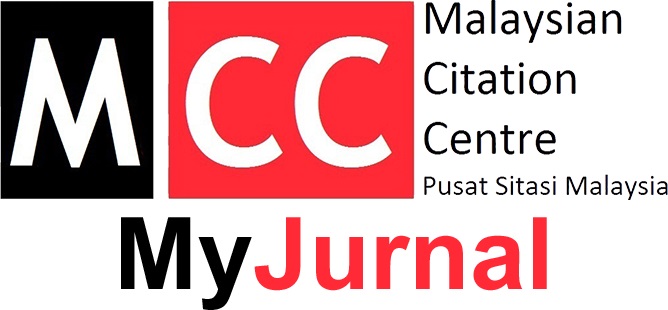A NEW APPLICATION OF N, N’-BIS[(BENZIMIDAZOL-1-YL)ETHYL]-4-METHYLBENZENESULFONAMIDE AS A CORROSION INHIBITOR FOR MILD STEEL
Keywords:
Acidic medium, corrosion inhibitor, mild steel, N-heterocyclic carbeneAbstract
Corrosion is the deterioration of material typically metal alloys that cause the main problems in the industry that is associated with significant economic losses, such as loss of their surface function and strength, reduction in efficiency, and increase in maintenance. Hence, procedures for the protection of the materials must be developed to minimise the damage effects of the metals. Organic ligands as corrosion inhibitors are known as one of the most effective, profitable, and easy techniques. This study discussed the synthesise and characterization of the compound from N-heterocyclic carbene (NHC) groups, namely N, N’-Bis[(benzimidazol-1-yl) ethyl] -4-methylbenzene sulfonamide (bis-benzimidazole). Its application as a corrosion inhibitor of mild steel in acidic media (1 M HCl and 1 M H2SO4) was investigated at different temperatures, times, inhibitor concentration, and salinity of the water. The structure of bis-benzimidazole was confirmed using Attenuated Total Reflection-Fourier Transform Infrared (ATR-FTIR), Ultraviolet-Visible (UV-Vis), and Nuclear Magnetic Resonance (NMR) spectroscopies. The bis-benzimidazole (0.01 M) was successfully used as the corrosion inhibitor in 8 h immersion time at room temperature with 100% and 92.51% inhibition efficiency in 1 M HCl and 1 M H2SO4, respectively. This showed that the bis-benzimidazole would adsorb chemically on a mild steel surface, which lead to the formation of a protective thin film with an inhibiting effect, thus inhibiting the corrosion activity.
References
Ahamad, I., Gupta, C., Prasad, R., & Quraishi, M. A. (2010). An experimental and theoretical investigation of adsorption characteristics of a Schiff base compound as corrosion inhibitor at mild steel/hydrochloric acid interface. Journal of applied electrochemistry, 40(12), 2171-2183.
Al-Baghdadi, S.B.; Hashim, F.G.; Salam A.Q.; Abed, T.K.; Gaaz, T.S.; AlAmiery, A.A.; Kadhum, A.A.H.; Reda, K.S.; and Ahmed, W.K. (2018). Synthesis and Corrosion Inhibition Application of NATN on Mild Steel Surface in Acidic Media Complemented with DFT Studies. Results in Physics, 8, 1178-1184.
Al-Mohammed, N. N., Alias, Y., Abdullah, Z., Shakir, R. M., Taha, E. M., and Hamid, A. A. (2013). Synthesis and antibacterial evaluation of some novel imidazole and benzimidazole sulfonamides. Molecules, 18(10), 11978–11995.
Ashassi-sorkhabi, H., Shaabani, B. and Seifzadeh, D. (2005). Corrosion inhibition of mild steel by some Schiff base compounds in hydrochloric acid. Applied Surface Science., 239, 154-164.
Elouadi, Y., Abrigach, F., Bouyanzer, A., Touzani, R., Riant, O., Elmahi, B., and Hammouti, B. (2015). Corrosion inhibition of mild steel by new N-heterocyclic compound in 1 M HCl : Experimental and computational study. Der Pharma Chem, 7(8), 265–275.
Galio, A. F., and Dariva, C. G. (2014). Corrosion Inhibitors – Principles, Mechanisms and Applications. Developments in Corrosion Protection, 16, 365-378.
Haque, R. A., Salman, A. W., Guan, T. S., and Abdallah, H. H. (2011). New N-heterocyclic carbene mercury(II) complexes: Close mercury-arene interaction. Journal of Organometallic Chemistry, 696(22), 3507–3512.
Ibrahim, M. F., (2013). Effect of different sodium chloride cocentration on corrosion of coated steel. Bachelor Theses and Dissertations, University Malaysia Pahang. Retrieved from http://umpir.ump.edu.my/id/eprint/8622/1/CD8025_@_40.pdf
Jamil, D. M., Al-Okbi, A.K., Al-Baghdadi, S. B., Al-Amiery, A. A., Kadhim, A., Gaaz, T. S., Kadhum, A. A. H., and Mohamad, A. B. (2018). Experimental and theoretical studies of Schiff bases as corrosion inhibitors. Chemistry Central Journal, 12(1), 1-9.
Mohammed, N. J., Othman, N. K., Taib, M. F. M., Samat, M. H., & Yahya, S. (2021). Experimental and Theoretical Studies on Extract of Date Palm Seed as a Green Anti-Corrosion Agent in Hydrochloric Acid Solution. Molecules, 26(12), 3535.
Muralisankar, M., Sreedharan, R., Sujith, S., Bhuvanesh, N. S. P., and Sreekanth, A. (2017). N(1)-pentyl isatin-N(4)-methyl-N(4)-phenyl thiosemicarbazone (PITSc) as a corrosion inhibitor on mild steel in HCl. Journal of Alloys and Compounds, 695, 171–182.
Nassar, E., and Nassar, A. (2016). Corrosion behaviour of some conventional stainless steels at different temperatures in the electrolyzing process. Energy Procedia, 93, 102-107.
Pavia, D. L., Lampman,G. M., Kriz , G. S. and Vyvyan, J. R., (2015). Introduction to spectroscopy. (5th ed.). Cenggage Learning, Canada: pp. 215-349.
Prawoto, Y., Ibrahim, K., & Wan Nik, W. B. (2009). Effect of pH and chloride concentration on the corrosion of duplex stainless steel. Arabian Journal for Science and Engineering, 34(2), 115.
Saeid, A. and Chojnacka, K. (2014). Sulfuric Acid. In Encyclopedia of Toxicology (3rd Ed.). Academic Press; pp. 424-426.
Şafak, S., Duran, B., Yurt, A., & Türkoğlu, G. (2012). Schiff bases as corrosion inhibitor for aluminium in HCl solution. Corrosion science, 54, 251-259
Said, N. R. (2016). Synthesis of new bis-n-heterocyclic carbene complexes and their applications as potentiometric sensor for Ag (I) and Hg (II) ions. Graduate Theses and Dissertations, University of Malaya Retrieved from http://studentsrepo.um.edu.my/6320/4/rahimah.pdf
Said, N. R., Rezayi, M., Narimani, L., Al-Mohammed, N. N., Manan, N. S. A., and Alias, Y., (2016). A New N-Heterocyclic Carbene Ionophore in Plasticizer-free Polypyrrole Membrane for Determining Ag+ in Tap Water. Electrochimica Acta, 197, 10–22.
Vinutha, M.R. and Ventakesha, T.V.V., (2016). Review on mechanistic action of inhibitor on steel corrrosion in acidic media. Portugaliae Electrochimica Act., 34(3), 157-184
Wang X.; Wan Y.; Zeng Y.; Gu Y. (2012). Investigation of Benzimidazole Compound as a Novel Corrosion Inhibitor for Mild Steel in Hydrochloric Acid Solution. International Journal of Electrochemical Science, 7, 2403- 2415
Downloads
Published
Issue
Section
License
Copyright (c) 2022 Journal of Academia

This work is licensed under a Creative Commons Attribution-NonCommercial-NoDerivatives 4.0 International License.












